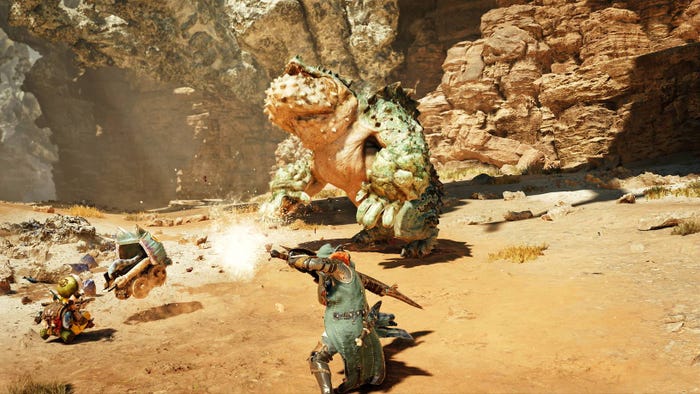Trending
Opinion: How will Project 2025 impact game developers?
The Heritage Foundation's manifesto for the possible next administration could do great harm to many, including large portions of the game development community.

Gamescom 2024 | Read more Gamescom coverage from the Game Developer team right here, including interviews from the show, analysis of leading developer trends, and more.
Conversations among peers and strong support for RE Engine make five-year-long dev cycles for games like Monster Hunter Wilds seem sustainable.

Has Capcom cracked the formula for a sustainable game studio? Not entirely. The upcoming Monster Hunter Wilds has taken about 5-6 years of development, so it's clear the Japanese developer/publisher is still taking the same big, risky bets on triple-A games that many of its peers are.
But unlike its peers, Capcom isn't suffering massive losses and stumbling through avoidable layoffs. It smashed sales records in 2023 and is still sailing strong through 2024, despite having no major upcoming releases until Monster Hunter Wilds lands in 2025. It's a little surreal to watch a company that once stumbled badly with its North American operation now seem like a pillar of stability.
What is it doing right? According to Wilds game director Yuya Tokuda, executive producer Ryozo Tsujimoto, and art director Kaname Fujioka, there isn't one practice propelling the studio along. But as they explained in a conversation at Gamescom 2024, there's a unique culture of communication across development of the widely-used RE Engine, among game developers on different games, and between developers and sales teams across the globe, that make its blockbuster strategy stand out in a turbulent 2024.
The technical Swiss Army Knife at the heart of Capcom's development process is RE Engine. Though the name references the long-running Resident Evil series it was first created for, it's been used since in games like Dragon's Dogma 2, Street Fighter 6, Devil May Cry 5, and even Ghosts 'n Goblins Resurrection.
The engine follows in the footsteps of MT Framework, Capcom's first studio-wide game engine that debuted in 2006's Dead Rising. Framework's legacy lives on in other ways too, according to Tsujimoto. "We're greatly focused on multiplatform releases at Capcom, and we need an engine that can work across multiple [types of] hardware," he said. MT Framework was a "great porting engine," and its strengths there were replicated for RE Engine's development.
Today, the Monster Hunter Wilds teams and other Capcom developers work "right alongside" the RE Engine engineers, and benefit from a "fast feedback loop" to request features or bugfixes slowing down development.
That seems simple enough on its face, but Capcom isn't the only game company to mandate use of a single internal engine. At companies like EA, the practice has been blamed for slowing down development on games not in based in the genre the engine was created to support. The difference, Tsujimoto explained, is that no single game or franchise has the final say on updates to RE Engine.

Image via Capcom.
"We have the flexibility to work with them on a priority list," he said. If the Monster Hunter Wilds team makes a request that the team can't immediately accommodate, they aren't told "no," they're brought into a conversation about the pipeline—one they can participate in because they're aware of every other game in development and their technical needs.
In fact, having developers at Capcom in constant conversation with each other is a common practice. From the way he described it, there doesn't seem to be a habit of siloing teams away from each other on secret or need-to-know projects. "Our teams all work closely together, even across different titles," he said. "We're able to share ideas and discoveries and technology with each other."
That sense of cooperation extends as far out as the sales teams in Japan and across the globe. Tsujimoto seemed to nod at the fact that the Monster Hunter series' massive sales numbers come from regions outside the US and Japan, saying the company has developed a "tight-knit" relationship with the teams marketing and distributing the game across those regions.
Close relationships between game developers and salespeople are slightly unusual—but the series' ever-growing popularity seems to be shaping the production process in a number of impactful ways.
Though not all of Monster Hunter Wilds' developers have been on the project for all 5-6 years of its development (Fujioka, the art director, said the team also worked on Monster Hunter Rise and its expansion Sunbreak in that time period), that's still an eye-popping amount of time to work on a single game. Fujioka told Game Developer that its expanded development was driven in part by the series' growing playerbase, whose existence increased the amount of time spent on research and development.
"The more people came on board the series, the more we had to think about how we actually meet our users' needs when we start a new project," he said. "There's so many more players now, and they [possess] a broader level of skill levels and experience with the [series]."
That's especially worth calling out with Wilds' major shakeups to the Monster Hunter formula. The game is set in a series of open worlds where players can take on more open-ended hunts, tracking different monsters and mimicking the role of a hunter in a real-world ecosystem. Not every player can smoothly navigate the jump from one type of gameplay to another, and accommodating them (seemingly with insights from the global sales teams) was a key part of the process.
As game director, Tokuda was the one who "felt" the long years developing Wilds, Tsujimoto joked. Tokuda told us he's been creatively invested of exploring the "monster ecosystem" at the heart of the series ever since he first saw the first game's trailer over 20 years ago. But for the team to push the boundaries of that development philosophy, it increases the scale of the project, which "inevitably has a resource cost, and one of those resources is 'time,'" he observed.
His passion for the "monster ecosystem" is palpable, telling us that Capcom has reached the point where it can "push the boundaries" on how it's represented on screen. "Not just in terms of graphical quality, but just being able to feel like you're leaping into this living, breathing world," he said.
Are half-decade-long development cycles worth that fantasy? For players, probably. For developers—well, we'll have to wait until 2025 to truly find out.
You May Also Like